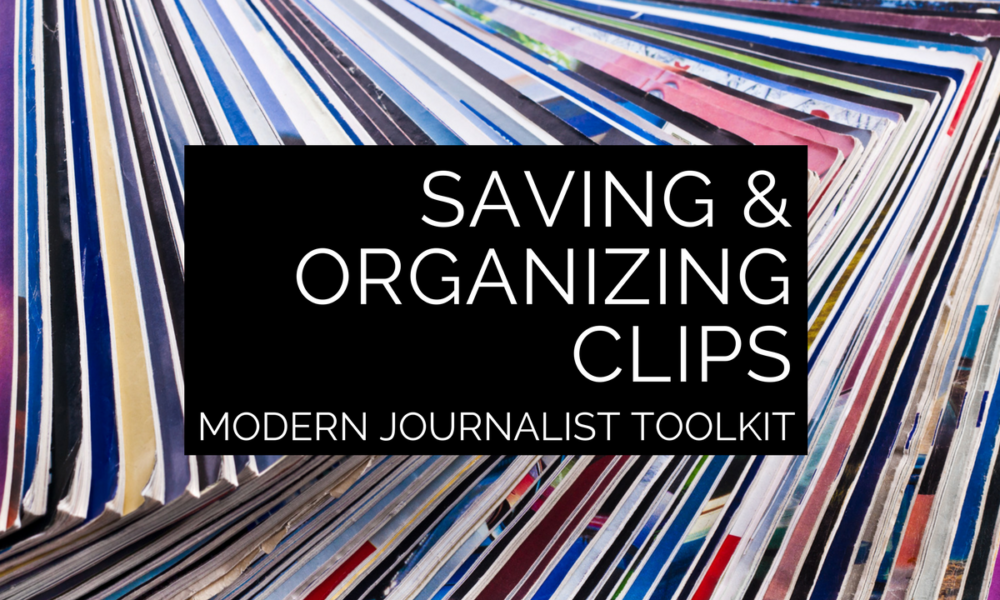Modern Journalist Toolkit 14: Saving and organizing clips

[2019 update:] Click to listen to an adapted version of this post on the Writing Coach Podcast:
The Writing Coach Podcast with Rebecca L. Weber: WCP41 Sorting and archiving freelance articles
Whether your articles are published online or in print, you need to be able to make them readily available for potential clients to read online. Simply having a list of links isn’t sufficient. Sites reorganize and your links go bad; your piece gets pulled or the publication closes; and paywalls prohibit access.
Way back in the day, our freelance ancestors clipped their articles out of paper magazines and newspapers with scissors, and made photocopies to send to editors. They sent the clips (or cuttings) with a system called snail mail. It cost money and it took days–many thousands of minutes longer than the emails and links we now use when we email our writing samples to an editor, or curate them online.
If you’ve been working as a freelance writer or journalist for a while, you may have a box of old clips in your storage unit or basement or that deepest space under the bed that you can’t reach without a broom handle. The only time I’ve shared paper copies with an editor was during an in-person meeting (and in most IRL cases, paper copies would in no way have been necessary or even welcome).
It doesn’t really matter if you have two clips or two thousand. If a potential client (or source) wants to read samples of your work, you need to be able to point to your best and most relevant pieces online.
You can use three main ways to showcase your writing samples to editors you want to work with: links to stories on the site where they were originally published, images of the print or online layout (such as a PDF on PNG file), or plain text on your website. (If you don’t have your own website, check out these super quick solutions for creating a digital portfolio.)
Let’s take a look at the pros, cons, and how tos of each.
Articles published online
If the story is published online, you have two main options. I recommend that you pursue both of these if you want to feature an article on your website or digital portfolio.
First is a clickable link to the article on the site where it was published. This is the quickest, easiest solution on your end. It serves as some social proof and avoids any legal issues. Make sure your piece is not behind a paywall.
On your own website, a link will suffice. If you use a digital portfolio site like Contently, double check that the correct article, headline, and photo/video are pulled in.
If it’s a piece that you want to highlight for new-to-you editors–that is, it’s not just part of your virtual basement box archive–I recommend that you have a separate full copy of the article. Active links (and publications themselves) don’t last forever.
You can copy and paste the text of the full article directly on your site. Plain text loads very quickly. The look may be basic, but assigning editors are much more concerned about your reporting and writing than they are about the beautiful final spread in a magazine. Again, you need to consider if you have retained the rights to the piece.
The other solution is to take a picture or screenshot of the entire piece and embed it on your site. I use a free tool called Nimbus that easily screenshots the entire page without scrolling. That .png image can then be uploaded to your digital portfolio.
Here’s a short demo of Nimbus in action:
The no-duh reminder: archive your clips soon after publication. Once the website has removed a published piece, you may be able to recover it via the Wayback Machine, but not always.
Digital copies of paper clips
If your story really is printed on paper, first of all, congrats. Paper is the new luxury.
The best, highest quality copy of your print story is going to be the electronic document (such as a PDF) that your editor sends you.
What? Your editor doesn’t send this to you automatically? Nope, mine doesn’t either. But I ask for the file, and usually receive it. You might ask your assigning editor if there’s somebody else who can help you, such as an intern who can help with this kind of admin tasks.
If for whatever reason the publication won’t send you an electronic copy, you’ll have to make your own. You can do this on a flatbed print scanner (available at many libraries).
Or, since you probably don’t have a flatbed scanner with you at all times, use your cell phone. I like an app called CamScanner, which renders images that are much easier to read than regular photos.
You may need to increase the quality or decrease the size; don’t assume that whatever the defaults are will work for your needs (basically, that sweet spot between fuzzy and slow downloads).
PDFs present their own set of problems. Email attachments can trigger spam, and may be hard or impossible to read on mobile devices.
Be aware it may not technically be legal for you to use these on your website. Even if you have retained the rights to your words, you may not have the rights to use the photographs or the graphic designer’s layout.
How do you get those great assignments that you’ll want to share with editors in the first place? If you want my blueprint for writing queries that editors find irresistible, download a copy of the free eguide, “5 Proven Steps to Writing Queries that Sell.”

 Download a free copy of “5 Proven Steps to Writing Queries that Sell.” I hate spam and will never share your info.
Download a free copy of “5 Proven Steps to Writing Queries that Sell.” I hate spam and will never share your info.